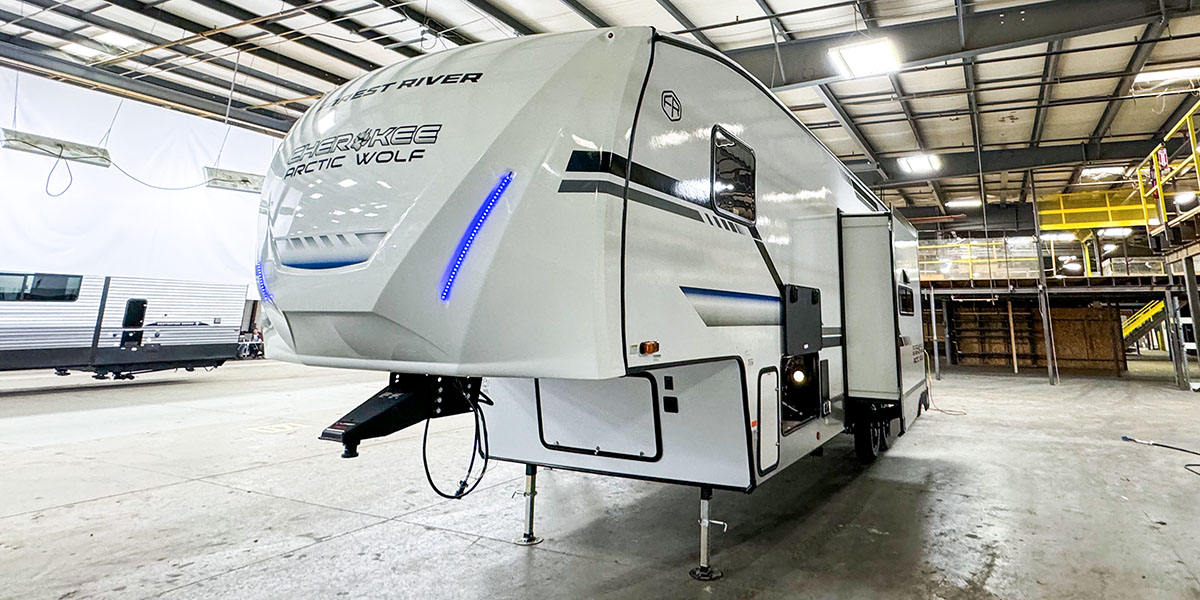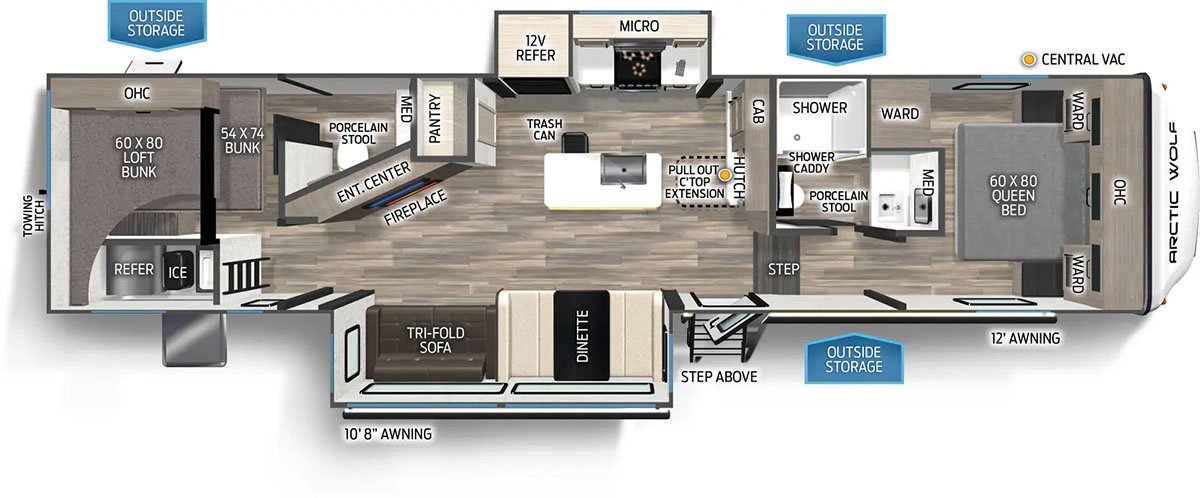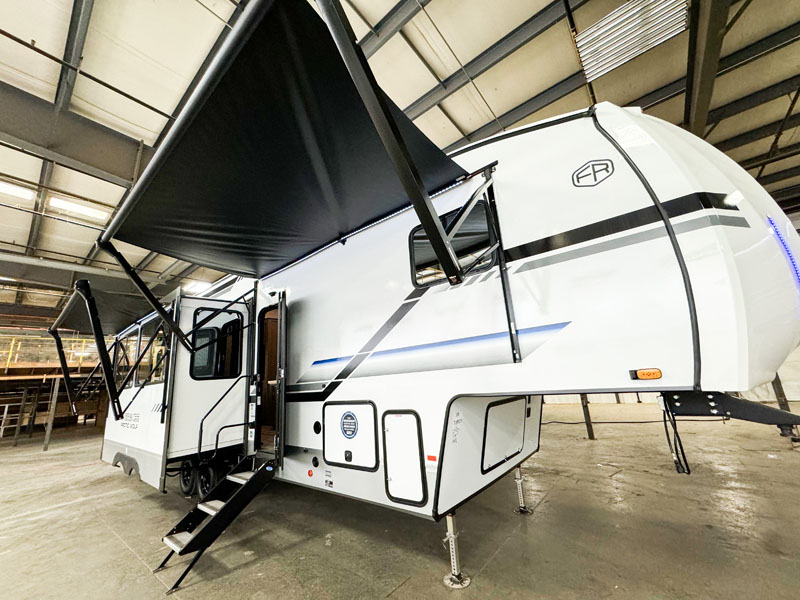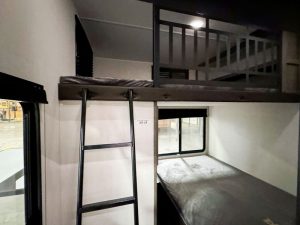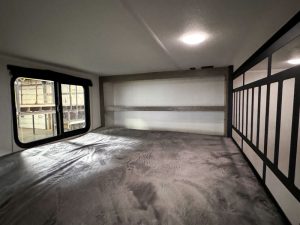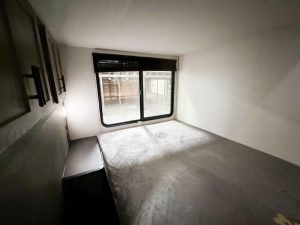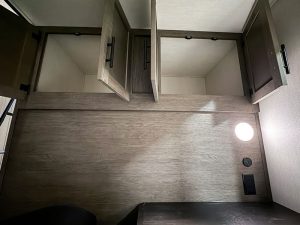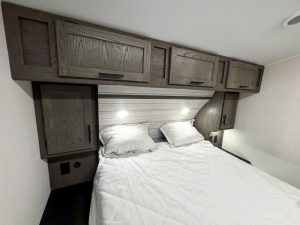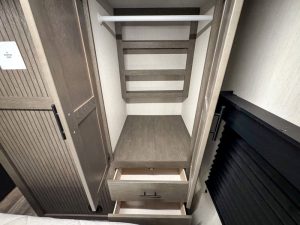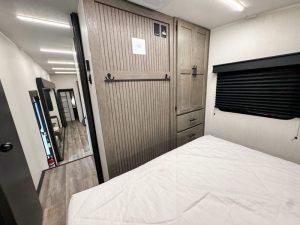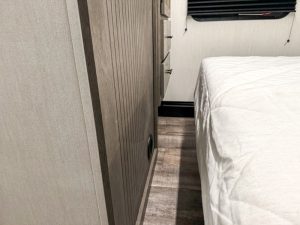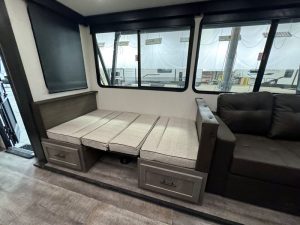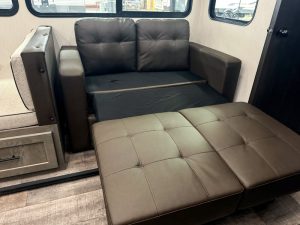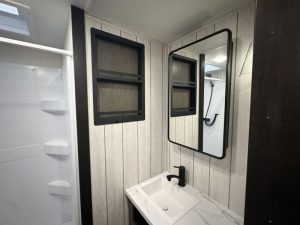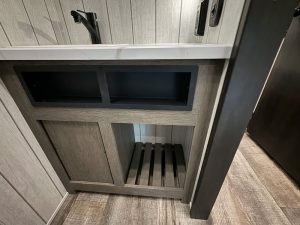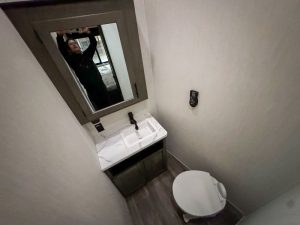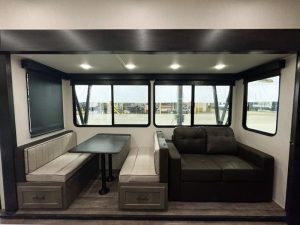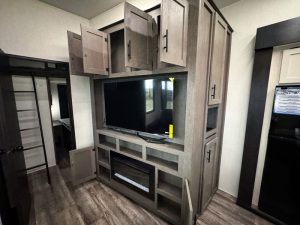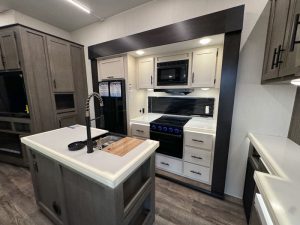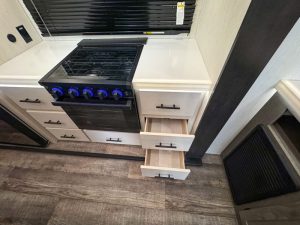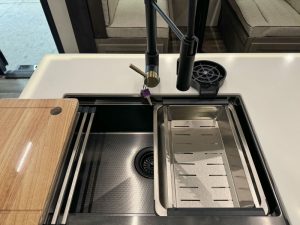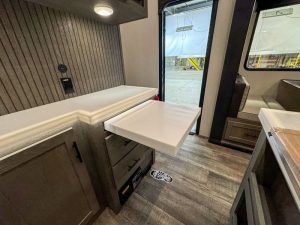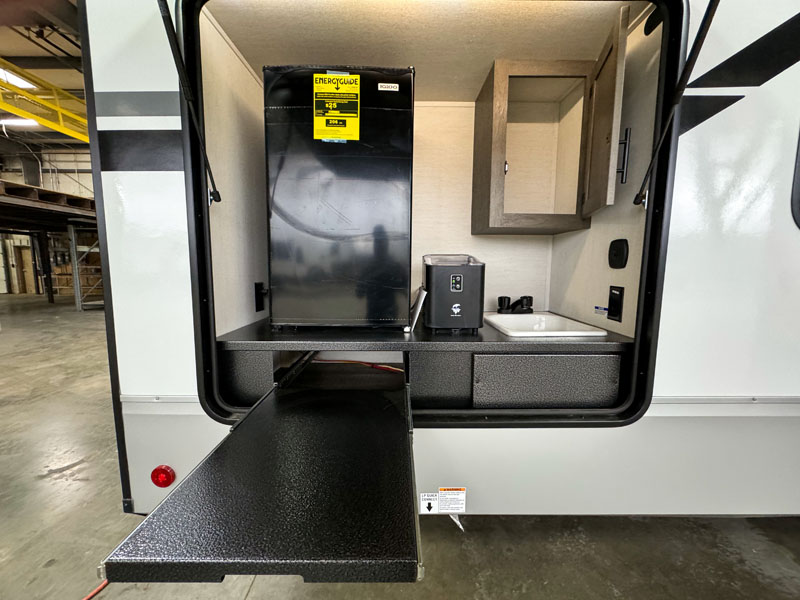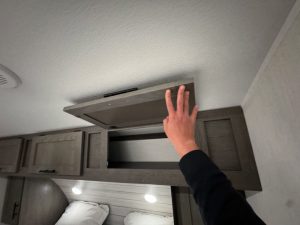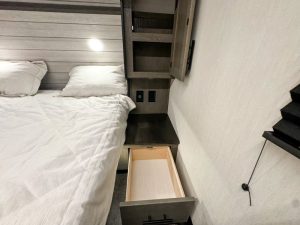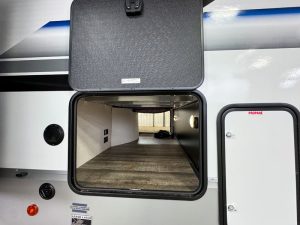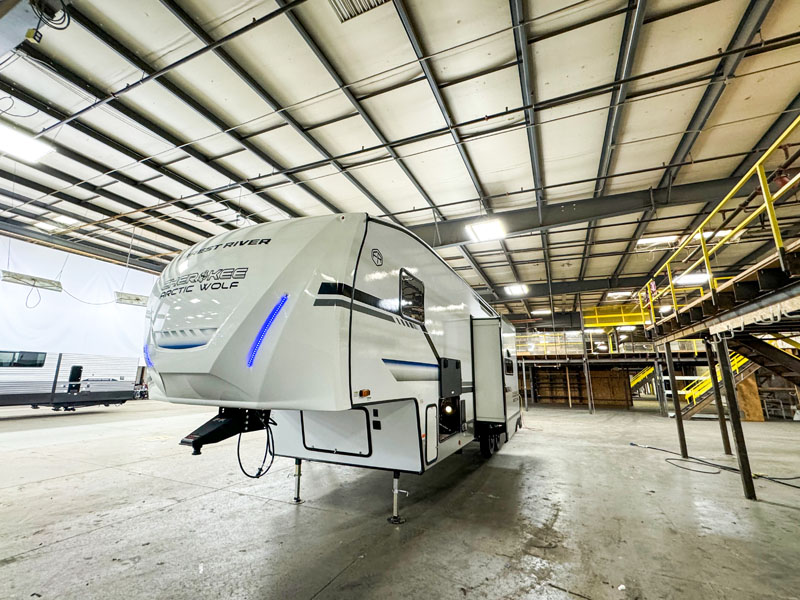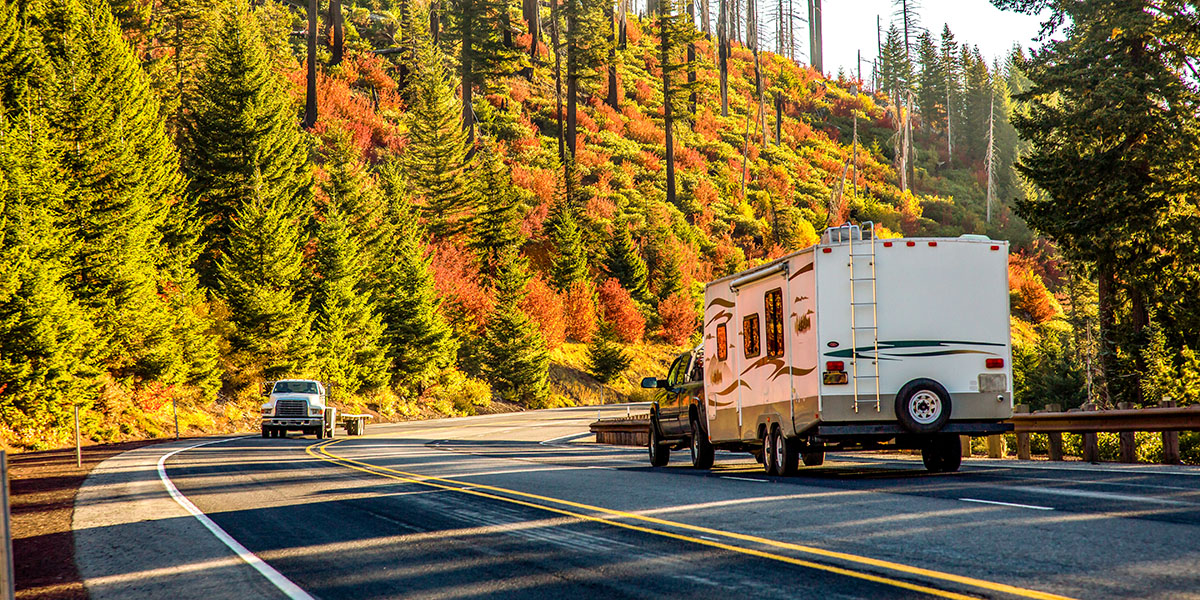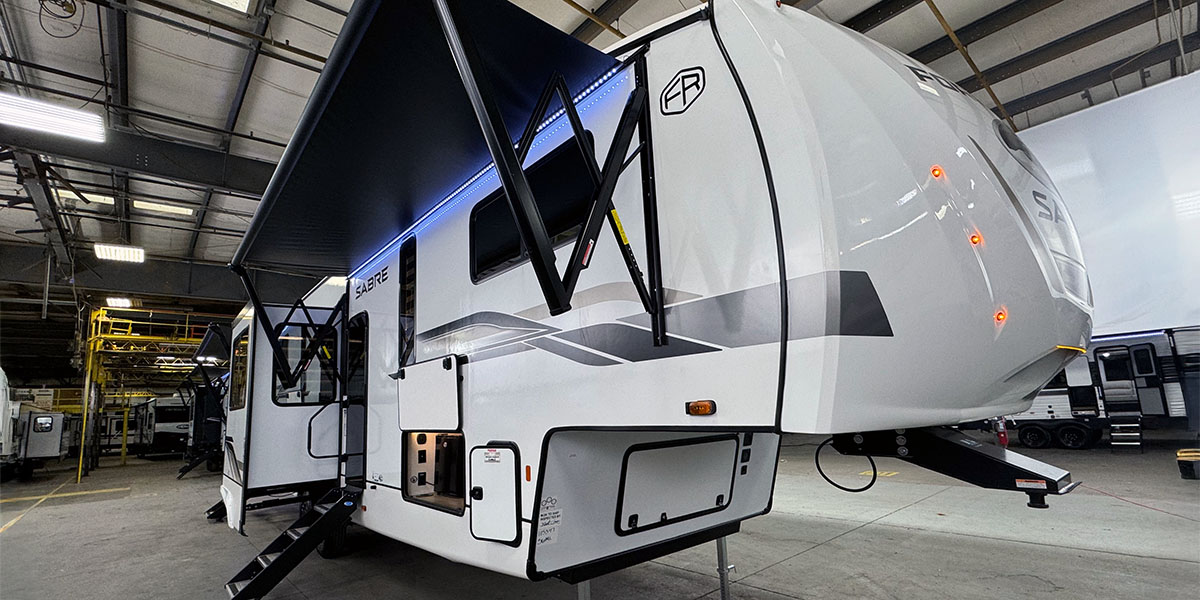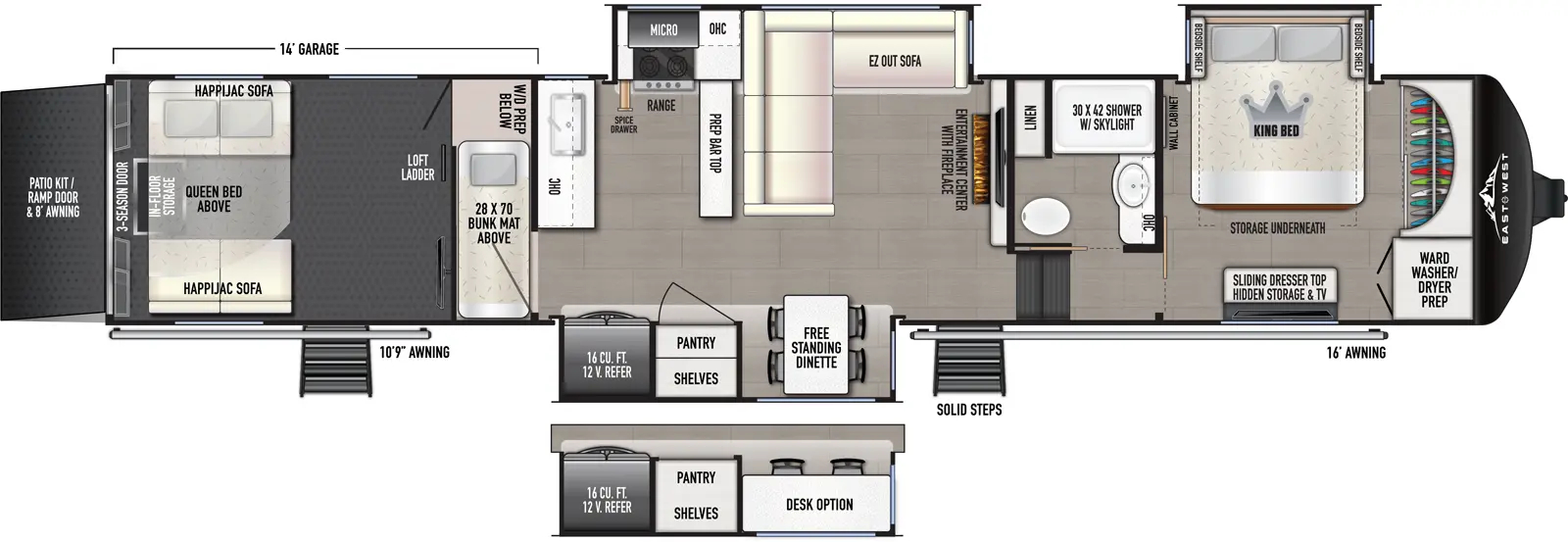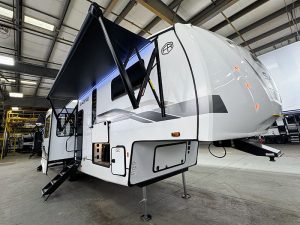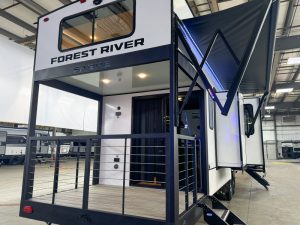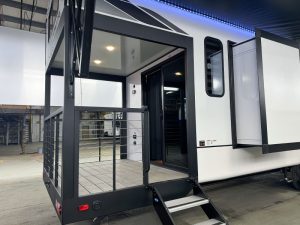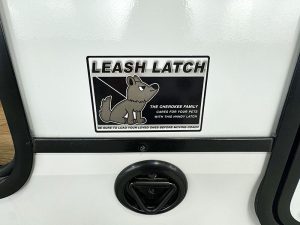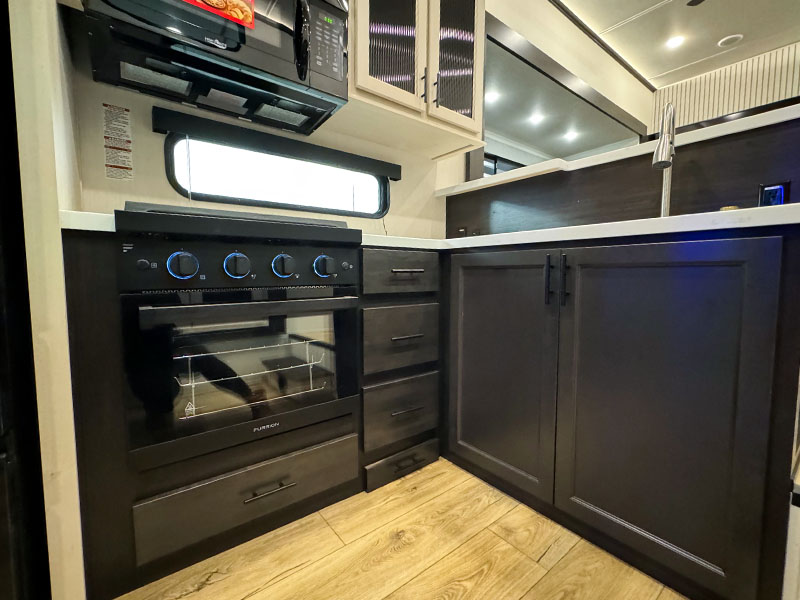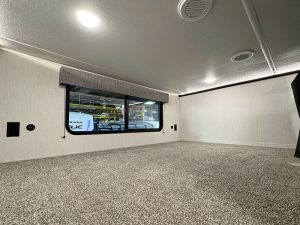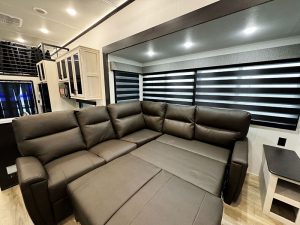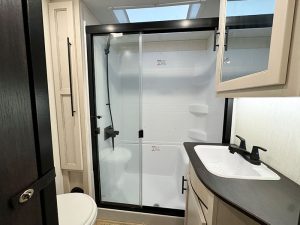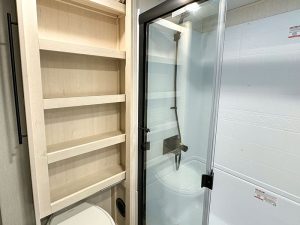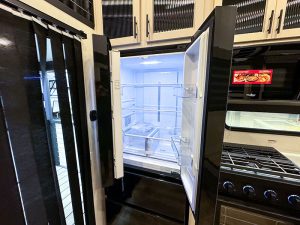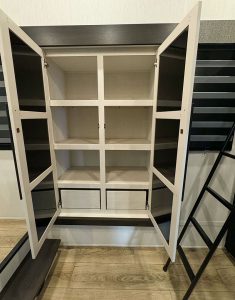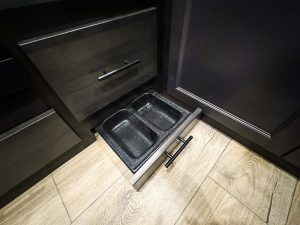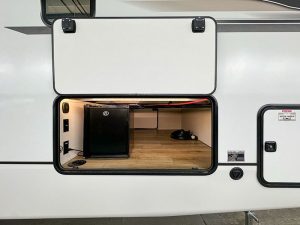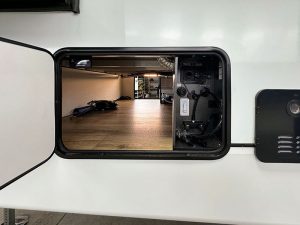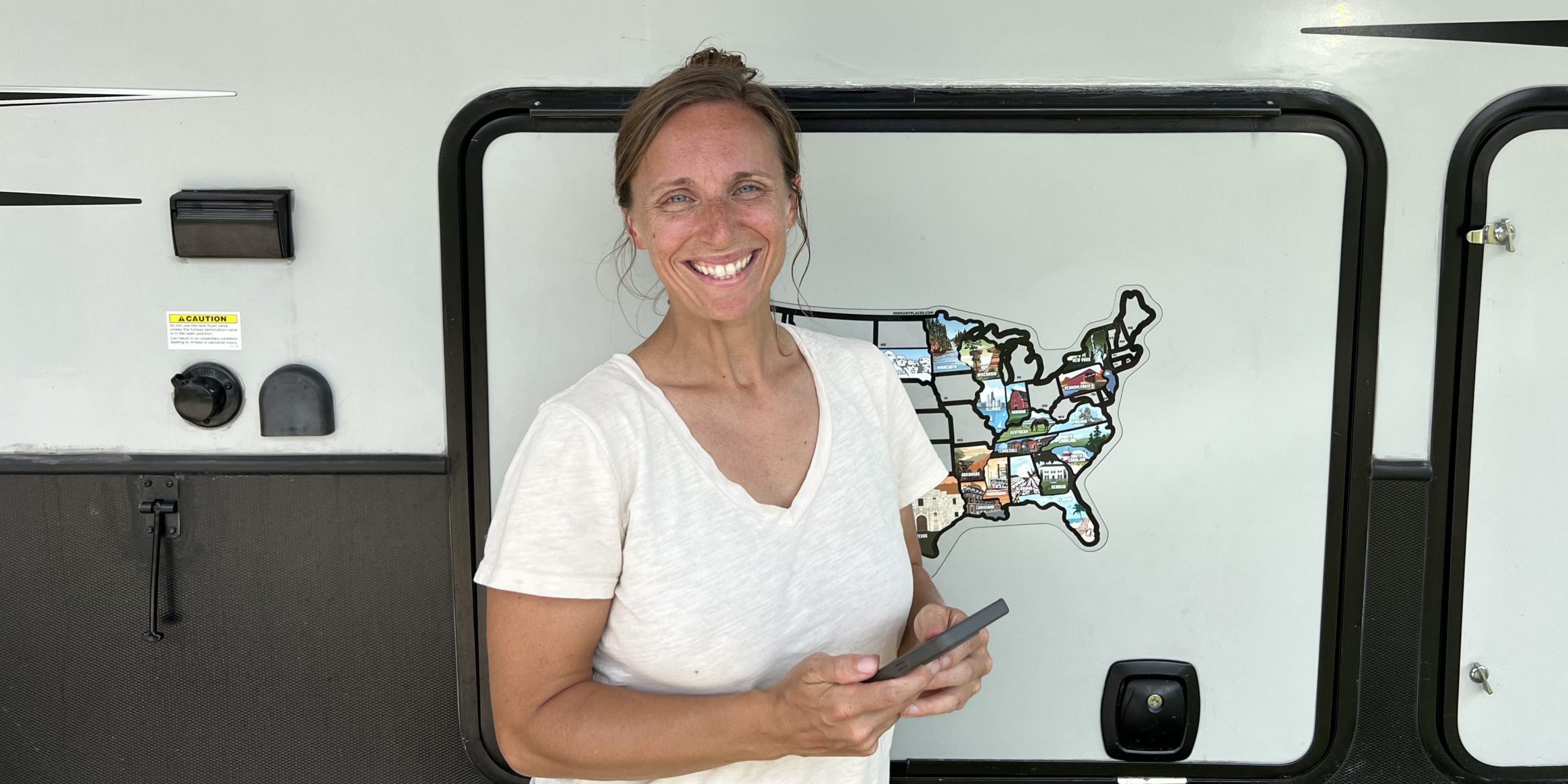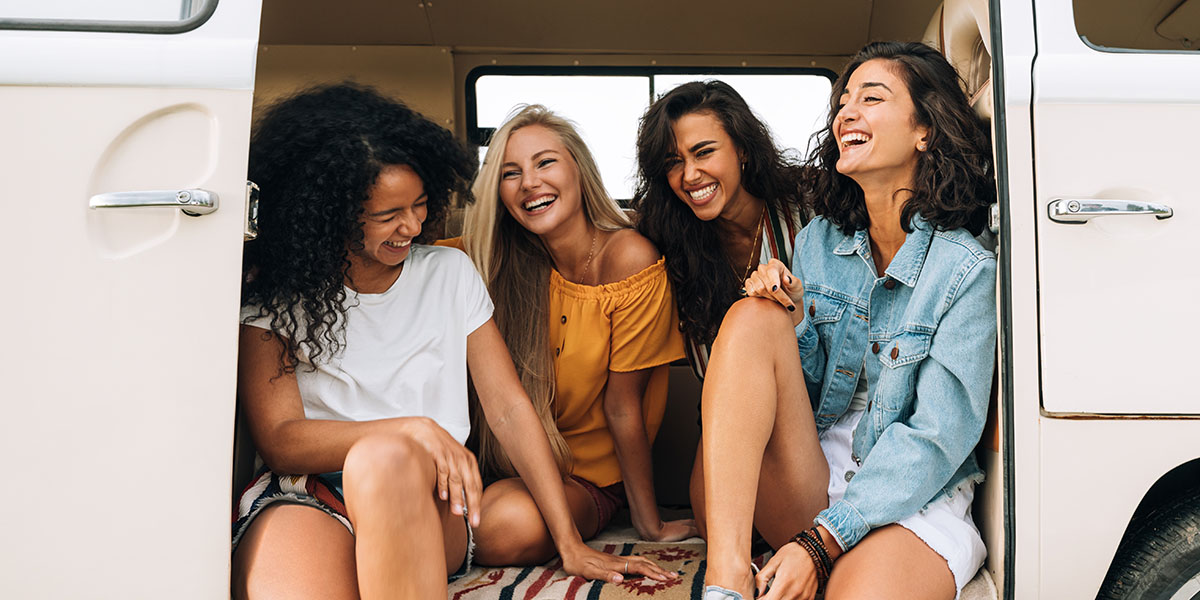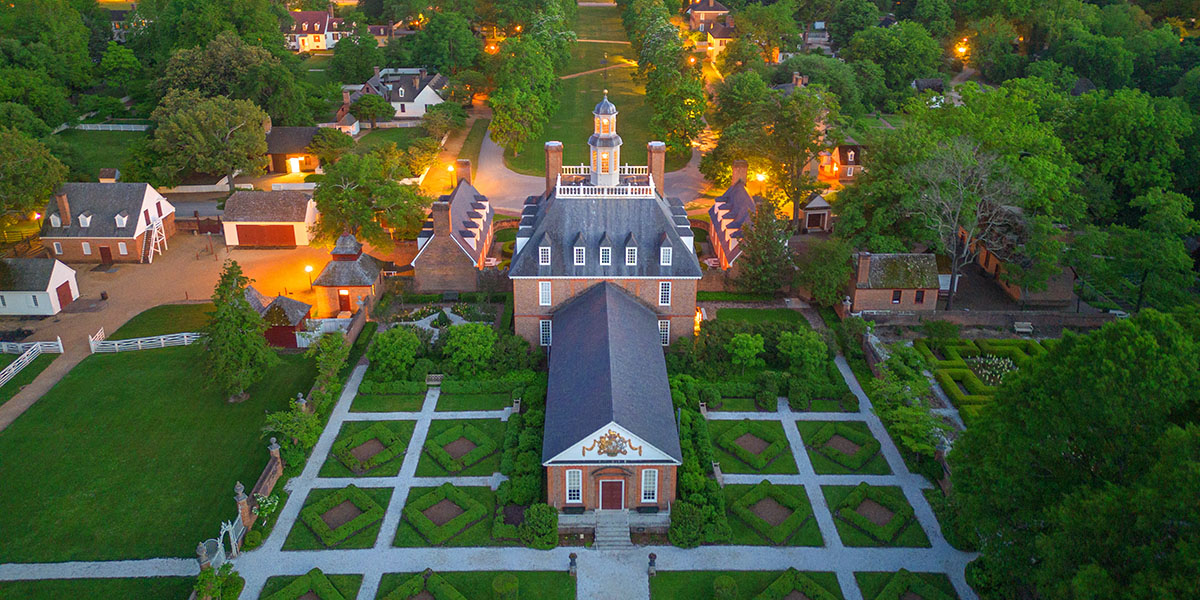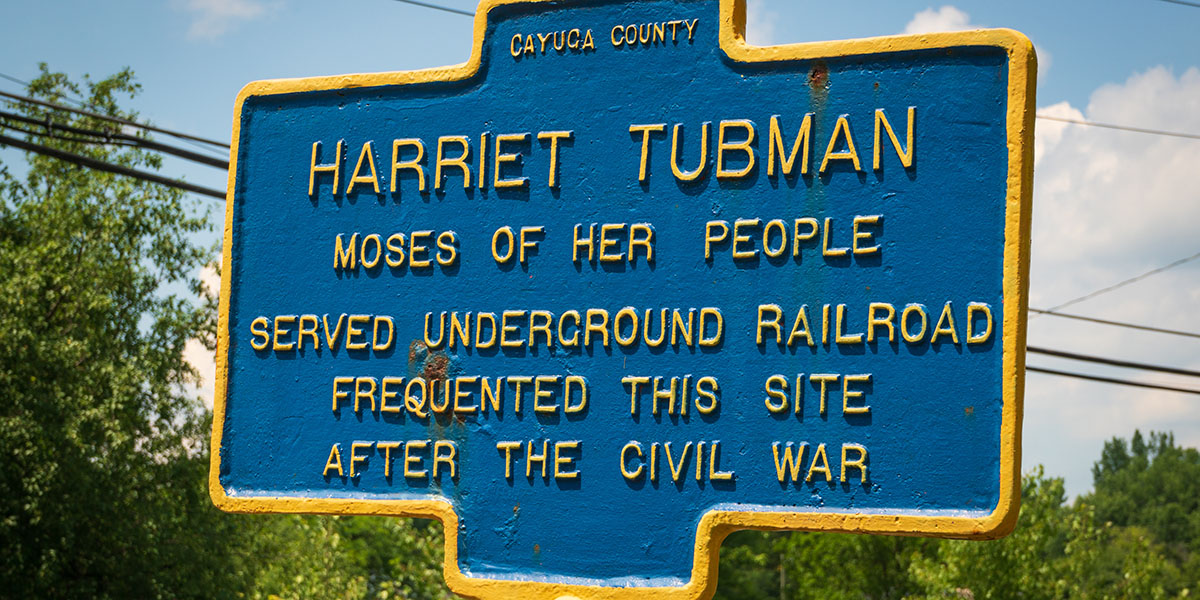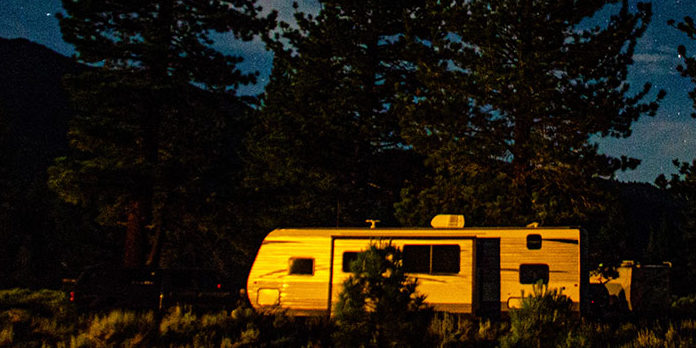The Arctic Wolf 331BH meets the needs of real-world families on the move. Little luxuries are delivered without exorbitant cost. The floor plan was made with your children as the priority. And you can unleash your culinary potential in the luxurious kitchen, both indoor and outdoor.
Too often, kids’ spaces are an afterthought in RV designs. Believe me, kids know when they have been made an afterthought – and they will fight back to regain center stage. In this model, they have their own room, bed, and bathroom.
For those looking for a spacious RV to vacation or live in with kids, this model might check all your boxes.
At a Glance: Arctic Wolf 331BH
We gave the Arctic Wolf 331BH an 8.0 out of 10. The price is right for a 38-foot fifth wheel that thoughtfully accommodates the whole family. On the surface, the unit is spot on (especially the kitchen and kids’ area). But some consumer reports call build quality into question. There are also some design flaws in the master bedroom that may hinder your overall comfort. But overall I was surprised at how the Arctic Wolf 331 BH stacked up next to other, more-expensive fifth wheels.
[review_summary class=”custom-class” title=”2025 Forest River Cherokee Arctic Wolf 331BH” description=”This score is awarded by an expert reviewer conducting an independent assessment of the RV.”]
Check the Specs
- Sleeping Capacity: 9
- Hitch Weight: 1,645 pounds
- UVW: 9,914 pounds
- CCC: 1,931 pounds
- Exterior Length: 38 feet 3 inches
- Exterior Height: 13 feet 2 inches
- Exterior Width: 8 feet
- Fresh/Grey/Black: 81/70/70 gallons
- Propane: 2 x 40-pound tanks
- Awnings: 10 feet 8 inches and 12 feet
Features We Love
- RoadVac central vacuum system
- A designated place to put your wine bottles!
- Two bathrooms!
- An incredible bunk house with a private bathroom
- Wonderful kitchen with tons of counter space
- Outdoor shower
- Leash latches
Benefits
- Keep bellies full and hearts happy with a residential kitchen and all the countertop space you could want.
- Bring your children along, and rest assured knowing their needs are met in the floor plan of this rig.
- Keep your interior clean by rinsing off muddy feet and muddy paws with the outdoor shower.
- Cleaning is a breeze with the central RoadVac.
Challenges
- Large overhead bunk has a 300-pound capacity. Good luck keeping all the kids, great and small, from hanging out there at once – with all their toys and things.
- The master bed doesn’t have enough space to walk around – and that’s before you hang your coats on the hooks and install the TV on the wall at the foot of the bed.
- There is a lot of dead space in the spare bathroom.
- Some of the cabinets don’t have doors.
- Many reports have been made regarding the build quality of the slide-outs and cabinetry.
Best For
- Families with kids that want to have friends or family come to visit
- Full-time traveling and roadschooling families
- Families that are looking for an affordably priced fifth wheel
Key Areas We Evaluate for RV Buyers
Sleeping Space
Kids’ Space
There’s a good chance that the kids’ space is actually a bit nicer than the master suite. And that’s not because the master suite is lacking! The bunk room really sets the bar high in this fifth wheel. And the kids have their own bathroom! If you want your kids to feel at home on the road, this rig provides that space.
The top bunk has a window and shelving at the foot of a queen-size bed. There are outlets and a charging port thoughtfully installed in the ceiling next to the shelves. My only issue with this space is that the weight capacity of 300 pounds seems a little low for such a large area. More than likely, this will be the most popular room in the house, and all the kids (and maybe neighboring kids at the campground) will want to take part in some fort magic up here. Just make sure you keep that 300-pound weight capacity in mind, especially if you intend to let adult-size visitors sleep here. A heavy-duty safety railing is installed, so you don’t have to worry about any bunk bed mishaps.
Below the top bunk is a double-size bed with loads of storage beneath it. There are two cabinets, charging ports, and reading lights next to the bed, with lots of open storage space below it.
Each bunk has a window, so your kids can watch the stars and have access to plenty of ventilation.
Master Suite
Situated at the nose of the trailer, the master suite is not as thoughtfully delivered as the bunk house. There is barely enough room to walk around the bed. If you mount the television where intended, you will need to crawl over the bed to get to the other side. And to top it off, they put coat hooks on the same wall, further affecting the functionality of the space.
There is nothing wrong with crawling over the bed, in fact, many RVers are forced to do much worse in the name of tiny spaces. But if you have to crawl over a newly made bed to access your clothes, then the unit probably shouldn’t advertise a walk-around bed. You need to know what you’re in for when purchasing your house on wheels. Like I say to my husband, “Don’t tell me we are going on a two-mile jog if it’s a five-mile run.” Some of us less adaptable adventures need to know what we are in for before we embark.
Bedroom Storage Space
The rest of the suite is a delight. The queen-size mattress has reading lights above it, and charging ports with outlets. There is an abundance of storage, with overhead cabinets above the bed, and cabinets on either side of the bed with drawers below them. The overhead cabinets however, lack anything to keep them open. You will have to reach and grab with one arm and use the other arm to hold the cabinet open. The mattress also has storage below the bed, with gas struts to make access a breeze.
In addition to all that cabinet and drawer space, there is a deceptively large wardrobe at the foot of the bed. (You will likely have to crawl over the bed to access it.) After opening the doors, I was surprised at the depth of space available. Additional shelves in the back make it easy to make full use of this deep closet space.
Conversion Beds
The dinette converts into a small bed, appropriate for a child. The trifold sofa folds out into a full-size bed, but would probably be a bit lumpy without an additional foam topper on it. If you have any insomniacs that are planning to visit, it might be worth having an additional layer of padding for their backs and hips. They will be in a much better mood to face the day.
Bathroom
One feature that I think makes the Arctic Wolf 331BH appropriate for full-time traveling families is the additional bathroom. It can be really hard to share one bathroom with growing kids on the road. In this model, two bathrooms make the experience that much more bearable.
The main bathroom is adjacent to the master suite. It feels spacious, with plenty of countertop space next to the sink. A porcelain foot-flush toilet with a high-performance fan meets up to the luxurious expectations of so many fifth wheels.
Storage, Spacing, and Small Details
The storage is tasteful and sufficient. The medicine cabinet is sleek with a beautiful pendant light set to the side. Storage is available inside the medicine cabinet and below the sink. There is a small recessed nook on the wall next to the sink for smaller bathroom items, and a small towel rack (for rolled up towels) above the toilet.
The shower insert is basic, but a decent size with a skylight above it. The shower head could use an upgrade, but that is common in most RVs — especially Forest River RVs.
This bathroom will likely be used by any guests that aren’t staying in the kids’ area. Call me selfish, but I do wish that the master bath was private to the master suite, and the kids’ bathroom was open to visitors. But I’m sure that there are various schools of thought on that!
The spare bathroom is tucked away in the corner of the kids’ space. It has all the necessary functions (except a shower – they will be sharing a shower with the master bath). Another high-performance fan is installed at the ceiling above a porcelain foot-flush toilet. The sink has a great range of counter space beside it, with a medicine cabinet above it for storage, and a cabinet below. There is some dead space behind and beside the toilet where I would have liked to see shelves, cabinets and/or towel racks and hooks.
Living Area
The living area is awash in natural light, with large windows throughout the space. The blinds are basic black-out pull-down shades. A two-seater sofa and dinette are tucked into the slide-out across from the kitchen. For the amount of sleeping space available in this unit, I would like to see one or two more seating options. The island could have incorporated a small bar top seating option. As it is now, only four can comfortably sit in this space, maybe 6 uncomfortably.
The 44-inch TV is directly across from the sofa. But anyone sitting in the dinette seat closest to the TV won’t be able to view it. It’s a shame to have such a large screen that only three people can comfortably view.
Under each dinette cushion are long, spacious drawers that pull out for abundant and easy-to-access storage. Above the TV are four overhead storage cabinets. Two cabinets rest on either side of the electric furnace, with three open shelving areas above.
Kitchen
If you like to cook for your family, this kitchen is a godsend for adventures on the road. Miles of countertop space will unleash your culinary potential. You can spread your wings and utilize your talent to the fullest. Ambient lighting beneath the countertops adds visual flair to the modern decor.
The sink takes center stage on a tasteful island in the middle of the living space. The large farmhouse-style basin is equipped with multifunctional sink strainers, cutting boards, more basins, and a glass cleaner. The sleek faucet has a tall flexible arm with a sprayer function.
And if you are especially greedy about your countertop space, there is an additional countertop feature that rolls out from the cabinet on the far wall. This wall is lined with half-depth cabinets, all equipped with seamless countertop space. Is it possible to have too much countertop space? I think we all know the answer to that question.
The three-burner Furrion range has 16-inches of counter on either side with a stove below for baking. A 10.6-cubic-foot fridge sits conveniently next to the stove. There are cabinets and drawers a-plenty in the kitchen. The mixed use of white and grey cabinet choices integrate the kitchen and living space nicely. The sink island has an array of cabinets and drawer space, and a convenient drawer for your trash.
Outside the rig I was met with a fully functional outdoor kitchen. It is equipped with a fridge, ice machine, sink, storage cabinet, pull-out table, and GFCI outlets. Wow.
Four-Season Capabilities
The term “Arctic” may be misleading to some consumers. This rig is definitely not intended for anything resembling an arctic climate, or even four-season usage. There are some attributes that may help extend the rig into some colder weather, such as the armored underbelly tank enclosure and 12V heating pads on the tanks. The upgraded laminated exterior walls have block foam insulation to enhance heat retention. This will all help protect key components during colder months, but it will not defend them entirely against freezing temperatures.
A 35,000-BTU furnace will provide robust heating during cold weather, and the 15,000-BTU central air condition with “Quick Cool” functionality will keep you cool in the summer. The model only comes with one AC, but is prepped for a second in the master bedroom.
Storage Space
The storage space in this unit is not lacking. The only downside is the absence of doors on many of the cabinets. Without a cabinet door, you have to worry about your things shifting around and possibly falling out while you’re on the road. I understand that it is a great way to cut down on weight and cost, but it also puts a heavy damper on the basic functionality of your storage spaces. There is a large passthrough storage unit under the rig, with an enclosed docking station. This will make set-up cleaner and more organized and will protect sensitive components from rain, snow, sun, and ice.
Chassis/Suspension
Equipped with the “Tough Bend” rigid skirt metal design, the frame on this rig is built for safety, and built to last. The leaf-spring suspension system is basic but tried-and-true. An automatic leveling and stabilization system will make set-up at your campsite, or off-grid, a breeze. For enhanced suspension performance, consider upgrading to the MORryde CRE3000 or the Trailair Equa-Flex system.
Off-Grid/Sustainability
Equipped with the Juice Pack Solar system, the Arctic Wolf 331BH comes with a 100-watt solar panel, battery disconnect, and a 30-amp solar charger. This will get you off the grid for a short time. If you are interested in staying longer, there is an option to add another solar panel. The on-demand tankless water heater will help conserve your fresh water by recirculating the cold water while it’s heating up.
Build Quality
The Cherokee Arctic Wolf brand isn’t necessarily known for impeccable build quality. If you do a little digging, you will see many complaints about slide-out mechanisms, underbelly sagging, cabinet defects, and much more. But that isn’t to say that these types of things aren’t common in most mid- to lower-range RVs. The cable-driven slide-out mechanism is lightweight, compact and easy to access. But they need maintenance to ensure proper tension, and are not as rugged as a rack-and-pinion or hydraulic system. Of course, this style of construction comes with a lower-than-average cost compared to many fifth wheels of similar size.
Value
The MSRP of the Arctic Wolf 331BH is around $95,000. After dealer discounts, you can find this RV around $50,000 at select dealers. That’s a pretty attractive figure for all the amenities offered. And especially when you consider the presence of a second bathroom. I have seen many luxurious fifth wheels catering to full-time traveling families at almost twice that cost – with just one bathroom.
Regardless of what unit you end up signing for, make sure you feel strongly about the integrity and quality of build. Inspect all the features, and ask about the mechanisms. If there is any question, make sure you understand the warranty terms and all the fine print before you pull the trigger.
Closing Notes on the Arctic Wolf 331BH
In conclusion, the 2025 Forest River Cherokee Arctic Wolf 331BH delivers a compelling balance of family-friendly design, thoughtful amenities, and affordability. With its standout bunkhouse, dual bathrooms, and expansive kitchen, this fifth wheel makes life on the road not just possible, but enjoyable for families who prioritize both comfort and practicality. While it does come with compromises in build quality and some cramped spaces in the master suite, its price point and overall livability make it an attractive option for parents who want their kids to feel at home wherever they travel.
Ultimately, the Arctic Wolf 331BH isn’t trying to be the most luxurious rig on the market – it’s aiming to be a reliable, functional, and welcoming space for families. If you’re a weekend adventurer, a full-time traveler with kids, or simply searching for a fifth wheel that makes family living easier without breaking the bank, the Arctic Wolf 331BH may be the right fit. Just be sure to inspect carefully before you buy, and you’ll likely find that this model delivers strong value where it matters most: keeping everyone comfortable, connected, and ready for the next adventure.
A Note on the RV Trader Review Process
RV Trader asked RV shoppers what was most important to them in their RV buying process. Potential buyers — like you — helped us to identify a list of six key areas that camping and travel enthusiasts always look at when they’re searching for the perfect RV: sleeping space, bathroom, living area, four-season capabilities, and storage space.
The RV Trader team then got to work providing you with honest and unbiased evaluations. If you’re wondering, that’s where I came in. As an RV expert and enthusiast, I provide an honest look at RVs from an RV industry insider perspective.
Make Your Move
Start shopping for the year, make, and model. Find Your Arctic Wolf
What Other Campers Are Saying
Read the best reviews by owners. Search for an RV Model
[marketplace_inventory_widget]
